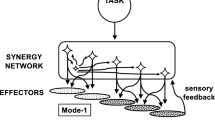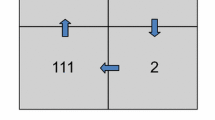Abstract
Two recent experiments have demonstrated that young adult participants were able to make faster and more harmonic movements in a typical reciprocal Fitts task (ID = 6) following a practice session of sine wave tracking (Boyle et al. in Exp Brain Res 223:377–387, 2012; J Mot Behav 46:277–285, 2014). The purpose of the present experiment was to replicate these findings with a young adult population (age 18–25) and determine whether sine wave tracking also enhances goal-directed limb movements in an older adult population (age 65–90). To establish a performance baseline, all participants were first pretested on a typical ID = 6 Fitts task. Participants in each age group were then randomly assigned to one of the two training conditions where they practiced (45 trials) on a typical Fitts task (ID = 6) or they were asked to track a sine wave template (45 trials). Following practice, all participants were then posttested under the ID = 6 Fitts conditions. The results demonstrated that both young and older adult participants that practiced under the sine wave conditions enhanced their Fitts task performance compared to participants in their respective age groups who practiced under the Fitts conditions. These enhancements included faster movement times, smaller dwell times, and more harmonic movements, all without decreases in movement accuracy. These results replicate our previous findings with young adults and extend the finding to older adult participants. Interestingly, the performances of the older adults following sine wave practice were as fast and as accurate as the young adults following Fitts task practice.



Similar content being viewed by others
References
Adam JJ, Paas FGWC (1996) Dwell time in reciprocal aiming task. Hum Mov Sci 15:1–24
Boyle JB, Shea CH (2011) Wrist and arm movements of varying difficulties. Acta Psychol 137:382–396
Boyle JB, Shea CH (2013) Micro-movements of varying difficulties: wrist and arm movements. Exp Brain Res 229:61–73
Boyle JB, Kennedy D, Shea CH (2012) Optimizing the control of high ID single degree of freedom movements: re-thinking the obvious. Exp Brain Res 223:377–387
Boyle JB, Panzer S, Wang C, Kennedy D, Shea CH (2013) Optimizing the control of high ID single degree of freedom movements: re-thinking the power of the visual display. Exp Brain Res 231:479–493
Boyle JB, Kennedy DM, Wang C, Shea CH (2014) The sine wave protocol: decrease movement time without increasing errors. J Mot Behav 46:277–285
Buchanan JJ, Park J-H, Ryu YU, Shea CH (2003) Discrete and cyclical units of action in a mixed target pair aiming task. Exp Brain Res 150:473–489
Buchanan JJ, Park J-H, Shea CH (2004) Systematic scaling of target width: dynamics, planning, and feedback. Neurosci Let 367:317–322
Buchanan JJ, Park J-H, Shea CH (2006) Target width scaling in a repetitive aiming task: switching between cyclical and discrete units of action. Exp Brain Res 175:710–725
Casiez G, Vogel D, Balakrishnan R, Cockburn A (2008) The impact of control-display gain on user performance in pointing tasks. Hum Comp Interact 23:215–250
Cooke JD, Brown SH, Cunningham DA (1989) Kinematics of arm movements in elderly humans. Neurobiol Aging 10:159–165
Debaere F, Swinnen SP, Beatse E, Sunaert S, VanHecke P, Duysens S (2001) Brain areas involved in interlimb coordination: a distributed network. Neuroimage 14:947–958
Debaere F, Wenderoth N, Sunaert S, Van Hecke P, Swinnen SP (2003) Internal vs external generation of movements: differential neural pathways involved in bimanual coordination performed in the presence or absence of augmented visual feedback. Neuroimage 19:764–776
Dounskaia N, Wislede D, Johnson T (2005) Influence of biomechanical factors on substructure of pointing movements. Exp Brain Res 164:505–516
Fernandez L, Bootsma RJ (2008) Non-linear gaining in precision aiming: making Fitts’ task a bit easier. Acta Psychol 129:217–227
Fitts PM (1954) The information capacity of the human motor system in controlling the amplitude of movement. J Exper Psychol 47:381–391
Fitts PM, Peterson JR (1964) Information capacity of discrete motor responses. J Exp Psychol 67:103–112
Fradet L, Lee G, Dounskaia N (2008) Origins of submovements during pointing movements. Acta Psychol 129:91–100
Goggin NL, Meeuwsen HJ (1992) Age-related differences in the control of spatial aiming movements. Res Q Exerc Sport 63:366–372
Guiard Y (1993) On Fitts’s and Hooke’s laws: simple harmonic movement in upper-limb cyclical aiming. Acta Psychol 82:139–159
Guiard Y (1997) Fitts’ law in the discrete vs. cyclical paradigm. Hum Mov Sci 16:97–131
Guiard Y, Beaudouin-Lafon M, Mottet D (1999) Navigation as multiscale pointing: extending Fitts’ model to very high precision tasks. In: Proceedings of the SIGCHI conference on human factors in computing systems. ACM, pp 450–457
Haaland KY, Harrington DL, Grice JW (1993) Effects of aging on planning and implementing arm movements. Psychol Aging 8:617–632
Kennedy DM, Boyle JB, Wang C, Shea CH (2014) Bimanual force control: cooperation or interference? Psychol Res. doi:10.1007/s00426-014-0637-6
Kennedy DM, Boyle JB, Rhee J, Shea CH (2015) Rhythmical bimanual force production: homologous and non-homologous muscles. Exp Brain Res 233:181–195
Ketcham CJ, Seidler RD, Van Gemmert AW, Stelmach GE (2002) Age-related kinematic differences as influenced by task difficulty, target size, and movement amplitude. J Gerontol B Psychol Sci Soc Sci 57:54–64
Kohl RM, Shea CH (1992) Pew (1966) revised: acquisition of hierarchical control as a function of observational practice. J Mot Behav 24:247–260
Kovacs AJ, Shea CH (2011) The learning of 90° continuous relative phase with and without Lissajous feedback: external and internally generated bimanual coordination. Acta Psychol 136:311–320
Kovacs AJ, Buchanan JJ, Shea CH (2008) Perceptual influences on Fitts’ law. Exp Brain Res 190:99–103
Kovacs AJ, Buchanan JJ, Shea CH (2010a) Perceptual and attentional influences on continuous 2:1 and 3:2 multi-frequency bimanual coordination. J Exp Psychol Hum Percept Perform 36:936–954
Kovacs AJ, Buchanan JJ, Shea CH (2010b) Impossible is nothing: 5:3 and 4:3 multi-frequency bimanual coordination. Exp Brain Res 201:249–259
Lorenzo-Lopez L, Amenedo E, Pascual-Marqui RD, Cadaveira F (2008) Neural correlates of age-related visual search decline: a combined ERP and sLORETA study. NeuroImage 41:511–524
Meyer DE, Abrams RA, Kornblum S, Wright CE, Smith JE (1988) Optimality in human motor performance: ideal control rapid aimed movements. Psychol Rev 93:340–370
Mottet D, Bootsma RJ (1999) The dynamics of goal-directed rhythmical aiming. Biol Cybern 80:235–245
Noble M, Fitts PM, Warren CE (1955) The frequency response of skilled subjects in a pursuit tracking task. J Exp Psychol 49(249):256
Pew RW (1966) Acquisition of hierarchical control over the temporal organization of a skill. J Exp Psychol 72:764–771
Pohl PS, Winstein CJ, Fisher BE (1996) The locus of age-related movement slowing: sensory processing in continuous goal-directed aiming. J Gerontol Psychol Series 51B:P94–P102
Proteau L (1995) Sensory integration in the learning of an aiming task. Can J Exp Psych 49:113–120
Rabbitt P (1979) How old and young subjects monitor and control responses for accuracy and speed. Br J Psychol 70:305–311
Reuter-Lorenz PA, Cappell KA (2008) Neurocognitive aging and the compensation hypothesis. Cur Direct Psychol Sci 17:177–182
Rey-Robert B, Temprado JJ, Lemaire P, Berton E (2012) Combining movement kinematics, efficiency functions, and Brinley plots to study age-related slowing of sensorimotor processes: insights from Fitts’ task. Gerontol 58:171–180
Salmoni AW, Schmidt RA, Walter CB (1984) Knowledge of results and motor learning: a review and critical reappraisal. Psychol Bull 95:355–386
Salthouse TA (1979) Adult age and the speed-accuracy trade-off. Ergon 22:811–821
Salthouse TA, Hancock HE, Meinz EJ, Hambrick DZ (1996) Interrelations of age, visual acuity, and cognitive function. J Gerontol B Psycholl Sci Soc Sci 51:P317–P330
Seidler RD, Bernard JA, Burutolu TB, Fling BW, Gordon MT, Gwin JT, Lipps DB (2010) Motor control and aging: links to age-related brain structure, functional, and biomechanical effects. Neurosci Biobehav Rev 34:721–733
Seidler-Dobrin RD, Stelmach GE (1998) Persistence in visual feedback control by the elderly. Exp Brain Res 119:467–474
Sleimen-Malkoun R, Temprado JJ, Berton E (2013) Age-related dedifferentiation of cognitive and motor slowing: insight from the comparison of Hick-Hyman and Fitts’ laws. Front Aging Neurosci 5:1–11
Swinnen S, Verschueren SMP, Bogaerts H, Dounskaia N, Lee TD, Stelmach GE, Serrien DJ (1998) Age-related deficits in motor learning and differences in feedback processing during the production of bimanual coordination pattern. Cogn Neuropsychol 15:439–466
Temprado JJ, Sleimen-Malkoun R, Lemaire P, Rey-Robert B, Retornaz F, Berton E (2013) Aging of sensorimotor processes: a systematic study of Fitts’task. Exp Brain Res 228:105–116
Voelcker-Rehage C (2008) Motor-skill learning in older adults-a review of studies on age-related differences. Eur Rev Aging Phys Act 5:5–16
Wang C, Kennedy DM, Boyle J, Shea CH (2013) A guide to performing difficult bimanual coordination tasks: just follow the yellow brick road. Exp Brain Res 230:31–40
Warabi T, Noda H, Kato T (1986) Effects of aging on sensorimotor functions of eye and hand movements. Exp Neurol 92:686–697
Welford AT (1981) Signal, noise, performance, and age. Hum Fact 23:91–109
Welford AT (1984) Between bodily changes and performance: some possible reasons for slowing with age. Exp Aging Res 10:73–88
Welford AT, Norris AH, Shock NW (1969) Speed and accuracy of movement and their changes with age. Acta Psychol 30:3–15
Winstein CJ, Schmidt RA (1990) Reduced frequency of knowledge of results enhances motor skill learning. J Exp Psychol Learn Mem Cogn 16:677–691
Wishart LR, Lee TD, Cunningham SJ, Murdoch JE (2002) Age-related differences and the role of augmented visual feedback in learning a bimanual coordination pattern. Acta Psychol 110:247–263
Woodworth RS (1899) The accuracy of voluntary movement. Psychol Rev 3:1–114
Wu T, Hallett M (2005) The influence of normal human ageing on automatic movements. J Physiol 562:605–615
Yan JH, Thomas JR, Stelmach GE (1998) Aging and rapid aiming arm movement control. Exp Aging Res 24:155–168
York JL, Biederman I (1990) Effects of age and sex on reciprocal tapping performance. Percept Motor Skills 71:675–684
Acknowledgments
This work was supported by research grants from the College of Education & Human Development, Texas A&M University and the Sydney & JL Huffines Institute for Sports Medicine & Human Performance, Texas A&M University to J.B. Boyle. The authors would also like to thank the owners, staff and volunteer members of Aerofit Health & Fitness Center for participation in this study.
Author information
Authors and Affiliations
Corresponding author
Rights and permissions
About this article
Cite this article
Boyle, J.B., Kennedy, D.M. & Shea, C.H. A novel approach to enhancing limb control in older adults. Exp Brain Res 233, 2061–2071 (2015). https://doi.org/10.1007/s00221-015-4277-x
Received:
Accepted:
Published:
Issue Date:
DOI: https://doi.org/10.1007/s00221-015-4277-x




